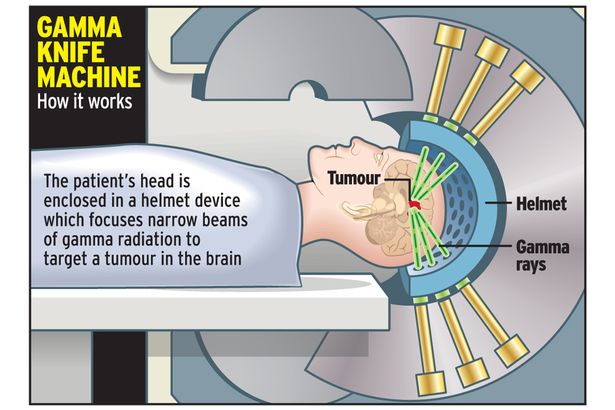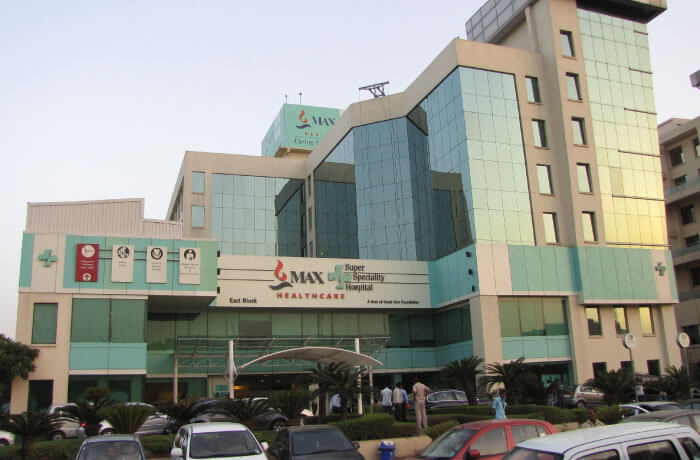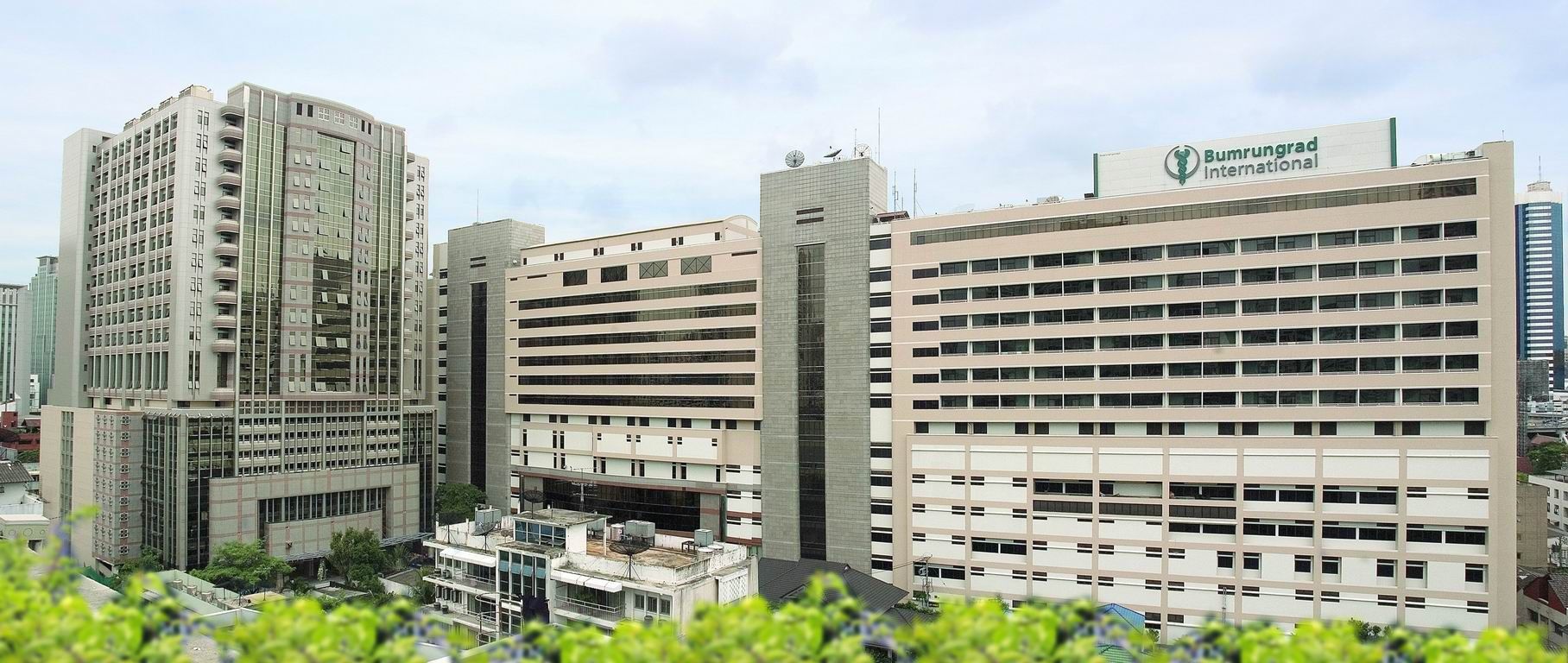Neuro & Brain
Gamma Knife for AVM or Brain Tumor Treatment
Gamma Knife Radiosurgery
Gamma Knife radiosurgery, also called stereotactic radiosurgery, is a very precise form of therapeutic radiology. Even though it is called surgery, a Gamma Knife procedure does not involve actual surgery, nor is the Gamma Knife really a knife at all.
What is Gamma Knife?
Gamma Knife radiosurgery is a type of radiation therapy used for treating tumors and other abnormalities in the brain. In Gamma Knife radiosurgery, specialized equipment focuses close to 200 tiny beams of radiation on the tumor or other targets. Although each beam has very little effect on the brain tissue, as it passes through, a strong dose of radiation is delivered to the site where all the beams meet. The precision of Gamma Knife radiosurgery results in minimum damage to healthy tissues surrounding the target. In some of the cases, Gamma Knife radiosurgery has a lower risk of side effects as compared with other types of radiation therapy. Also, Gamma Knife radiosurgery is very often a safer option than a traditional brain surgery.
Gamma Knife radiosurgery is often a one-time therapy completed in a single day. Gamma Knife radiosurgery is a very precise form of radiation therapy that focuses intense beams of gamma rays with inch-perfect accuracy to treat lesions in the brain. Despite its name, Gamma Knife surgery neither involves an actual knife nor traditional surgery. Gamma Knife radiosurgery is referred to as a “surgery” because its outcome is similar to that of a surgical procedure. Gamma Knife radiosurgery can be very effective in treating tumors, blood Vessel malformations, and nerve conditions. In each instance, surgeons and radiation oncologists use the Gamma Knife system a bit differently:
- Radiosurgery for tumor treatment works by damaging or destroying the DNA of tumor cells so that these cells cannot grow and reproduce. As the time progress, the brain tumor shrinks.
- For blood vessel malformations, such as an arteriovenous malformation, Gamma Knife treatment gradually closes off the malformed blood vessels.
- In the case of the pain disorder trigeminal neuralgia, where nerves are the target for treatment radiosurgery diminishes the function of improperly acting nerves, thus causing relief.
Why Gamma Knife is done?
Gamma Knife radiosurgery is used to treat certain conditions of the brain, many of which could only be treated by open surgery if this option was not available. Gamma Knife radiosurgery can be used on both children and adults. Gamma Knife radiosurgery is a better alternative than a standard brain surgery (neurosurgery), which requires incisions in the skull, membranes surrounding the brain and brain tissue.
This type of radiation treatment is usually done when:
- A tumor or other abnormality in the brain is too hard to reach with standard brain surgery
- A person isn't healthy enough to undergo any standard surgery

- A person opts a less invasive treatment
Gamma Knife radiosurgery is very often used to treat the following conditions:
- Brain tumor: Radiosurgery is very useful in the management of small noncancerous and cancerous brain tumors. Radiosurgery damages the genetic material in the tumor's cells. The cells lose their ability to reproduce and may die, and the tumor may gradually shrink over time
- Arteriovenous malformation (AVM): AVMs are abnormal tangles of arteries and veins in the brain. In an AVM, blood flows from the arteries to veins, bypassing smaller blood vessels (capillaries). AVMs may disrupt the normal flow of blood which leads to bleeding. Radiosurgery closes the blood vessels and thus destroying the AVM.
- Trigeminal neuralgia: Trigeminal neuralgia is a disorder of one or both of the trigeminal nerves, which relay sensory information between your brain and areas of your forehead, cheek, and lower jaw. This nerve disorder causes disabling facial pain that may feel like an electric shock After treatment, many people experience pain relief within a few days to a few months.
- Acoustic neuroma: An acoustic neuroma is a noncancerous tumor that develops along the main balance and hearing nerve leading from your inner ear to your brain. A person can experience hearing loss, dizziness, loss of balance and ringing in the ear, when the tumor puts pressure on the nerve. As the tumor grows, it can also put pressure on the nerves which affect sensation and muscle movement in the face. Radiosurgery may help in minimizing the size of an acoustic neuroma or even stop the growth with little risk of permanent nerve damage.
- Pituitary tumors: Tumors of the bean-sized gland at the base of the brain (pituitary gland), can cause various problems. The pituitary gland controls hormones in our body that control various functions, such as stress response, metabolism and sexual function. Radiosurgery can be used to shrink the tumor and thereby lessen the disruption of pituitary hormone regulation.
Risks:
Although Gamma Knife radiosurgery is less invasive than traditional open surgery however there is a possibility that there may be some side effects and risks due to Gamma Knife Radiosurgery.
- Radiation therapy is not suggested to women who are pregnant. Women of childbearing age may need to provide a urine sample before undergoing Gamma Knife treatment to ensure they are not pregnant.
- Other side effects include cerebral edema, headache, nausea, numbness or weakness in the face, loss of balance, vision problems, hair loss near the treated area (the hair loss is generally temporary) and seizures. Medication can be used for above-mentioned side effects. There may be other risks, depending on one’s specific medical condition. Any Discomfort should be immediately discussed with the physician prior to the procedure.
Early complications or side effects are usually temporary. They may include:
- Fatigue: For the first few weeks after Gamma Knife radiosurgery, the patient may feel fatigue and tiredness.
- Swelling: Swelling in the brain at or near the treatment site can cause a headache, nausea, and vomiting. The doctor may prescribe anti-inflammatory medications (to prevent such problems or to treat symptoms if they appear.
- Scalp and hair problems: The patient’s scalp may be red, irritated or sensitive at sites where a device is attached to your head during the treatment. Some people might lose a small amount of hair, but that is for a small amount of time. It is very rare that people experience late side effects, such as other brain or neurological problems, months after Gamma Knife radiosurgery.
Facilities and Services offered for International Patients for Gamma Knife Surgery
International patients with Gamma Knife surgery needs are accommodated by many medical centres around the world. These amenities and services are developed for the smooth and comfortable treatment considering all possible aspects of the treatment, including transportation and further rehabilitation. Here’s what international patients can typically expect:
- Comprehensive Pre-Arrival Assistance
- Dedicated Patient Coordinators
- Accommodation and Transportation Services
- Cultural and Dietary Accommodations
- Advanced Treatment and Recovery Support
- Post-Treatment Care and Follow-up
Pre-Treatment Process of Gamma Knife Radiosurgery
A usual pre-treatment protocol is performed to make the Gamma Knife radiosurgery treatment runs thoroughly safe, optimum and precise. Here’s an overview of the typical steps in the pre-treatment process:
- Initial Consultation and Evaluation
- Treatment Planning and Simulation
- Treatment Planning by the Multidisciplinary Team
- Patient Preparation
- Patient Counselling and Support
Diagnostic Tests for Gamma Knife Brain Surgery
Gamma Knife brain surgery patients may require several diagnostic tests before the procedure. These tests are very useful in both diagnosis of the disease, localization of the treatment area and safety of the patient. Here are the most common diagnostic tests used:
- MRI
- CT Scan
- Angiography
- PET Scan
- Neurocognitive and Neurological Assessments
- Blood Tests and General Health Screening
- ECG ad Cardiac Evaluation
Gamma Knife Radiosurgery Treatment Procedure
Patient Positioning: The patient lies on Gamma Knife treatment couch and frame or mask is fixed to the treatment system in order not to move.
Radiation Delivery:
- The couch moves the patient into the Gamma Knife machine where about 200 beams of radiation are brought together and concentrated to the affected part of the brain.
- This means the rays are brought in from various directions, focusing on point where the abnormal tissue is located so as to give it a high dose while helping the rest of healthy tissue as much as possible.
- These treatments each take between 15 minutes and 2 hours of session time on average depending on the circumstances of the size of the treatment area and the dose to be administered.
Patient Comfort: The patient is awake and is able to talk to the treatment team through an intercom during the entire procedure. They may listen to music or request a break if needed to.
Post-Treatment Process of Gamma Knife Radiosurgery
A typical post-treatment period of Gamma Knife radiosurgery depends on the patient’s improvement and progress as well as, the actual outcome of the procedure. Here’s what patients can typically expect after Gamma Knife radiosurgery:
- Immediate Post-treatment Recovery
- Managing Short-term Side Effects
- Follow-up Appointments
- Long-Term Monitoring and Assessment
- Addressing Delayed Side Effects
- Emotional and Psychological Support
- Lifestyle and Activity Recommendations
Gamma Knife Surgery for Trigeminal Neuralgia
Gamma Knife radiosurgery for trigeminal neuralgia is an effective, non-invasive treatment, as well as targeting the etiology of the condition without the need for antiepileptic medications or prior neurosurgical treatment. This procedure is safe with high success rate, quick recovery and is therefore an attractive solution for this disabling condition. If you are suffering from trigeminal neuralgia and want to explore other options before going under the knife, then, discussing with your doctor opportunities to schedule Gamma Knife radiosurgery might be of help.
Gamma Knife for Meningioma
The Gamma knife for meningioma is one of the most effective treatments of the meningiomas that can be used in cases when traditional surgery is difficult or impossible. It has no direct contact hence no blood loss, minimal downtime, very high success rate and it’s precise. Experience of the use of Gamma Knife in the treatment for patients with meningiomas, particularly for those with malignant or recurrent cases, shows that Gamma Knife can offer an effective way of tumor management as well as symptom alleviation which is useful in the present day neurosurgery.
Gamma Knife Stereotactic Radiosurgery
Gamma Knife Stereotactic Radiosurgery is an outpatient procedure that is minimally invasive and excruciatingly accurate in treating some primary brain pathology disease such as tumors, arteriovenous malformations, and certain neurological diseases. However, it is important to note that while the name given to it is surgery, they do not actually involve actual cuts or conventional surgery. However, it applies ionised radiation to the malignant or abnormal tissues within the brain with a lot of precision.
Success Rate of Gamma Knife Therapy
The success rate of Gamma Knife radiosurgery is high ranging from 80 to 95% across the various conditions or diseases. This success rate indicates it acts as an effective treatment modality for controlling or downsizing targeted abnormalities such as tumors, vascular malformations and nerve diseases, while also relieving symptoms.
Best Hospitals for Gamma Knife Radiation Surgery
- Artemis Hospital, Gurgaon
- Medanta The Medicity, Gurgaon
- Fortis Memorial Research Institute, Gurgaon
- Max Hospital, Saket
- BLK-Max Super Speciality Hospital, New Delhi
Best Doctors for Gamma Knife Radiation Surgery
- Dr. Aditya Gupta
- Dr. V.P. Singh
- Dr. Sandeep Vaishya
- Dr. Jitender Pal Singh
- Dr. S. Hukku
Why Choose GetWellGo for Gamma Knife Radiosurgery?
Selecting GetWellGo for Gamma ray surgery also includes several options that can improve the treatment process while receiving care for international patients. Here’s an overview of why GetWellGo might be an ideal choice:
- World-Class medical Facilities
- State-of-The-Art Facilities
- Comprehensive Pre-and Post-Treatment Care
- Tailored Services for International Patients
- Patient-Centred Approach and Personalized Care
- Transparent and Cost-Effective Care
- Seamless Follow-up and Telemedicine Services
- Travel and Accommodation Services
- Visa Assistance
Conclusion
Gamma ray surgery is a very innovative method of tumor treatment for different diseases of the brain; it is performed without surgery and provides highly effective radiation therapy. Because it can produce radiation to a specific area in the body and avoid symptoms similar to surgery, it may suit patients who want shorter recovery time and few side effects. The procedure is, therefore, considered to be very effective it has success rates of between 80% and 95%, depending on the ailment being corrected. In performing Gamma Knife radiosurgery, the following benefits are derived from the procedure; the procedure is very accurate, and Gamma Knife can also target those areas in the brain which are difficult to access.
FAQ
1. How can Gamma Knife Radiosurgery be beneficial?
- Non-Invasive: There are no incisions needed during surgery and this means less opportunity for something to go wrong.
- Precision: Confines radiation on a specific region to reduce over exposure of other parts of the brain.
- Quick Recovery: Full recovery from this illness is rather fast and most of the patients can return to their normal activities in several days.
- Effectiveness: Control over tumors, AVMs and neurological disorders are often outstanding.
- Minimal Side Effects: They said it has fewer side effects as compared to the typical brain surgery.
- Outpatient Procedure: Patients can be treated as outpatients and majority of them can go home immediately after treatment.
2. What is the success rate of Gamma Knife Radiosurgery?
The success rate of Gamma Knife radiosurgery varies by condition:
- Benign brain tumors: 85–95% control
- Metastatic brain tumors: 80–90% control
- Arteriovenous malformations (AVMs): Depending on the size of the lesion about 70 – 95% obliteration.
- Trigeminal neuralgia: 80–90% pain relief
- Acoustic neuromas: 90–95% tumor control
- Pituitary tumors: Reduced tumor growth by 85 - 95%, hormone levels Normalization by 60 – 70%.
3. How long does it take to recover after Gamma Knife Radiosurgery?
The recovery time after Gamma Knife is typically very short:
- Immediate recovery: Headache and fatigue are common and rather mild and patients can easily continue with their daily activities in 1 to 2 days.
- Long-Term Monitoring: Any tumor reduction or alleviation of symptoms may take several weeks to a few months to reach their optimum level. Further imaging is planned to be done on a follow-up basis in order to track the improvement or lack thereof.
- Minimal Discomfort: Any pain felt after the procedure at the pin sites (where the frame is used) will only last a few days.
TREATMENT-RELATED QUESTIONS
GetWellGo will provide you end-to-end guidance and assistance and that will include finding relevant and the best doctors for you in India.
A relationship manager from GetWellGo will be assigned to you who will prepare your case, share with multiple doctors and hospitals and get back to you with a treatment plan, cost of treatment and other useful information. The relationship manager will take care of all details related to your visit and successful return & recovery.
Yes, if you wish GetWellGo can assist you in getting your appointments fixed with multiple doctors and hospitals, which will assist you in getting the second opinion and will help you in cost comparison as well.
Yes, our professional medical team will help you in getting the estimated cost for the treatment. The cost as you may be aware depends on the medical condition, the choice of treatment, the type of room opted for etc. All your medical history and essential treatment details would be analyzed by the team of experts in the hospitals. They will also provide you with the various types of rooms/accommodation packages available and you have to make the selection. Charges are likely to vary by the type of room you take.
You have to check with your health insurance provider for the details.
The price that you get from GetWellGo is directly from the hospital, it is also discounted and lowest possible in most cases. We help you in getting the best price possible.
No, we don't charge patients for any service or convenience fee. All healthcare services GetWellGo provide are free of cost.
Top Doctors for Neuro & Brain
Top Hospitals for Neuro & Brain
Contact Us Now!
Fill the form below to get in touch with our experts.



%20Joy%20Dev%20Mukherji.jpg)



